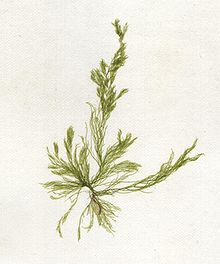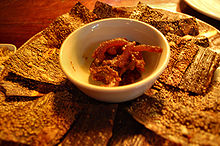- Cladophora
-
Cladophora Scientific classification Kingdom: Plantae Division: Chlorophyta Class: Ulvophyceae Order: Cladophorales Family: Cladophoraceae Genus: Cladophora
Kützing, 1843Cladophora is a genus of reticulated filamentous Ulvophyceae (green algae). The genus Cladophora contains many species that are very hard to tell apart and classify, mainly because of the great variation in their appearances, which is affected by habitat, age and environmental conditions.[1] Unlike Spirogyra the filaments of Cladophora branch and it doesn't undergo conjugation. There are two multicellular stages in its life cycle - a haploid gametophyte and a diploid sporophyte - which look highly similar. The only way to tell the two stages apart is to either count their chromosomes, or examine their offspring. The haploid gametophyte produces haploid gametes by mitosis and the diploid sporophyte produces haploid spores by meiosis. The only visible difference between the gametes and spores of Cladophora is that the gametes have two flagella and the spores have four. The Cladophora species can be a major nuisance causing major alteration to benthic conditions linked particularly with increased phosphorus[clarification needed] loading.
Contents
Laotian Mekong Weed
In Laos, Cladophara spp. (ໄຄ [kʰáj] "river weed" or more precisely ໄຄຫີນ [kʰáj hǐːn] "rock river weed") are commonly eaten as a delicacy and usually know in English under the name "Mekong weed". The algae grow on underwater rocks and thrive in clear spots of water in the Mekong river basin. They are harvested 1 to 5 months a year and most often eaten in dry sheets (ໄຄແຜ່ນ [kʰáj pʰɛ̄ːn] -kháy sheets-), much like Japanese nori, though much cruder in their format. Luang Prabang's speciality is dry khai with sesame, while Vang Vieng is famous for its roasted kháy sheets. They can be eaten in strips as an appetizer or with a meal. Luang Prabang kháy sheets are the most readily available form of Mekong Weed and are famous throughout the country and in the neighbouring Isaan, though difficult to find beyond Vientiane. Mekong weed can also be eaten raw, in soups, or cooked - as in a Lao amok preparation called ຫມົກໄຄ [mók kʰáj].
Invasive Species
Cladophora is accused of damaging the fishing industry and shoreline property values along the Great Lakes in the United States. Quagga mussel populations have also increased tremendously in the same time frame. [2]
Diversity
Species include:
- Cladophora aegagrophila
- Cladophora albida
- Cladophora brasiliana
- Cladophora catenata
- Cladophora coelothrix
- Cladophora columbiana
- Cladophora dalmatica
- Cladophora fracta
- Cladophora glomerata
- Cladophora graminea
- Cladophora montagneana
- Cladophora ordinata
- Cladophora prolifera
- Cladophora rupestris
- Cladophora scopaeformis
- Cladophora sericea
- Cladophora vagabunda
Notes
- ^ Gestinari, L., et al. (2010). Distribution of Cladophora species (Cladophorales, Chlorophyta) along the Brazilian Coast. Phytotaxa 14 22.
- ^ http://www.jsonline.com/news/wisconsin/29561884.html Great Lakes, Great Peril: Biological Pollution - 'The beach speaks for itself' - June 29, 2008
External links
References
- Guiry, M.D.; Guiry, G.M. (2008). "Cladophora". AlgaeBase. World-wide electronic publication, National University of Ireland, Galway. http://www.algaebase.org/search/genus/detail/?genus_id=37. Retrieved 2009-02-06.
- T. J. Entwisle & M. D. Guiry (2005-11-12). "Cladophora Kützing 1843: 262". AlgaeBase. http://www.algaebase.org/generadetail.lasso?genus_id=37.
- Cladophora Index. Monterey Bay Aquarium
- Marsin, P. and J. Tomasz. (2005). Introductory studies on the morphology of the genus Cladophora from the Gulf of Gdańsk. Ocean. Hydrob. Studies, 34(Supl.3): 187-193
Categories:- Cladophoraceae
- Ulvophyceae stubs
Wikimedia Foundation. 2010.


